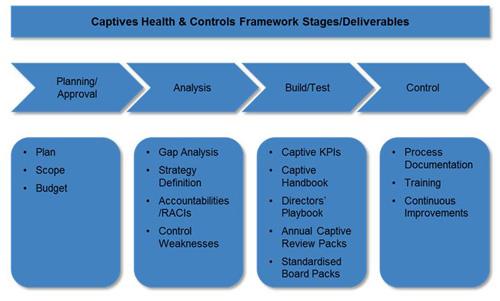
In moving from a vendor finance partnership to fully-fledged captive, manufacturers face a new set of challenges, particularly in areas such as governance and compliance.
Even established captives can benefit from reviewing these areas regularly, thereby realising enhanced operational processes and controls, reduced risk as well as greater portfolio and profit performance.
In today’s captive financing universe, the manufacturer’s business focus is on getting the captive buildout completed on plan in a controlled manner and then quickly initialising the operation in order to get new business flowing through.
The typical captive build will follow a number of well-established project phases covering the entire process from initial design to operational implementation:-
Experience indicates that there is often insufficient attention given to the Transition/Control phase post the captive going live.
One of the most important elements of this phase is having a comprehensive captive governance infrastructure that provides a control framework underpinning the captive’s operations. This framework incorporates the establishment and documentation of processes and handbooks covering such areas as the:
• captive legal/regulatory rules;
• compliance requirements;
• product offerings;
• local programmes; and
• end-to-end processes, other supporting processes and systems.
It also covers the captive’s regulatory/filing requirements, directors’ roles and responsibilities and deals with the annual captive performance review process, annual accounts and board meeting processes.
Potential issues from weak captives’ governance
Lack of an adequate and effective captive control framework can have several direct and indirect consequences for the business giving rise to a number of potential issues:-
• captive’s and manufacturer’s strategy and business objectives that are not completely aligned which can drive the wrong investment decisions resulting in an inadequate ROI;
• roles and responsibilities within the captive that may not be clearly defined, leading to a lack of, or poor controls and sub-optimal captive performance;
• captive operational performance that is not adequately measured or managed on a consistent basis which could lead to portfolio losses and impact future growth;
• an incomplete knowledge of the captive’s business/operational capabilities and supporting systems infrastructure which can result in new business opportunities being missed or lost;
• risks and potential losses to the captive, the parent manufacturer and its respective board of directors from weak captive governance structures;
• potential legal sanctions imposed on captive board of directors resulting from an incomplete knowledge and understanding of the local country regulatory, tax and compliance regulations; and
• senior management making incorrect business decisions from not having a comprehensive and consistent set of review templates for the annual review of the captive’s operational and financial performance.
A framework for assessing captives’ operational health and controls
In order to ensure its captive clients avoid these issues, Invigors has developed a “Captives Health and Controls Framework”, a program that delivers a structured framework supporting this critical Transition & Control phase, as well as providing a “healthcheck” for established captive operations.
This framework is based on a standardised methodology and template approach covering the planning, building, implementation and control phases of the project.
The initial part of the programme is focused on planning and scoping the project to ensure that the critical gaps and requirements are identified upfront. Deep-dive analysis is then undertaken for the critical areas identified and a remedial action plan agreed as necessary to address these gaps.
Outputs, including playbooks and handbooks, are generated and delivered in a consistent and standardised template format. The programme also includes appropriate training for the captive’s executives, directors and staff members.
Impacts and benefits from adopting the captives health & control framework
A well-executed captive health and controls framework project should have substantial positive impacts on:-
• the manufacturing entity’s confidence and willingness to invest in their captive;
• the captive’s portfolio and profit performance;
• enhanced captive operational process and controls;
• enhanced compliance with local regulatory requirements;
• reduced risk for directors of both the captive and manufacturer;
• smoother audit completion; and
• functional teams fully trained and developed on the captive’s products and processes.
Captive leasing companies and their manufacturer parents can benefit from this type of comprehensive and structured approach which will result in a robust captive governance framework capable of meeting the demands of national regulators and corporate compliance.
The effective application of this framework should deliver a captive environment with strong risk and control structures leading to profitable and risk controlled captives that fully support the manufacturer’s business strategy and objectives.
Kieran O’Brien is an associate at Invigors EMEA
kieran.obrien@invigors.com








